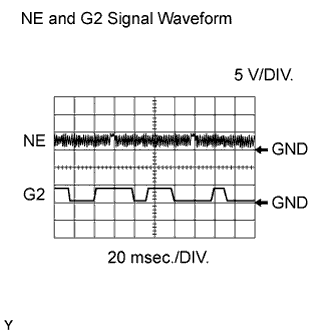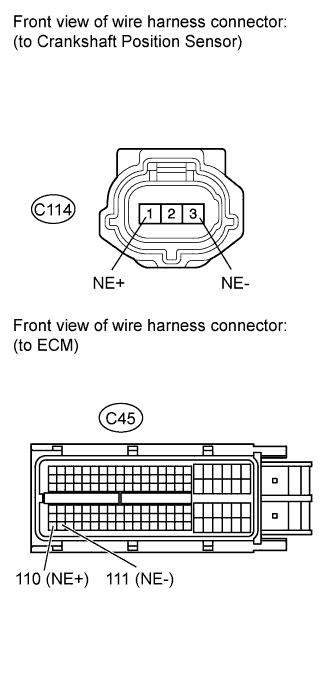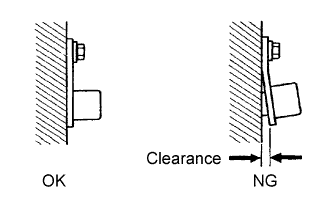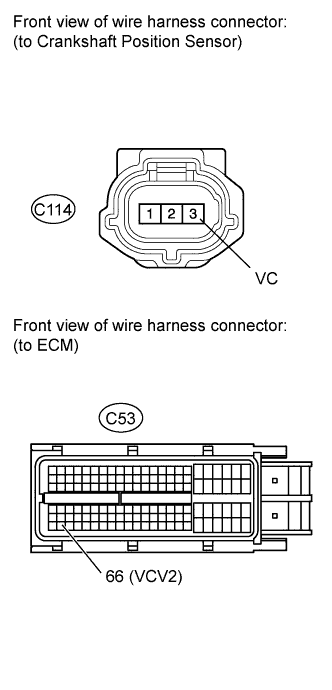READ VALUE USING INTELLIGENT TESTER (ENGINE SPEED)
INSPECT CRANKSHAFT POSITION SENSOR (SENSOR POWER SOURCE)
CHECK HARNESS AND CONNECTOR (CRANKSHAFT POSITION SENSOR - ECM)
CHECK SENSOR INSTALLATION (CRANKSHAFT POSITION SENSOR)
CHECK CRANKSHAFT POSITION SENSOR PLATE (TEETH OF SENSOR PLATE)
REPLACE CRANKSHAFT POSITION SENSOR
CHECK WHETHER DTC OUTPUT RECURS (DTC P0335, P0337, P0338 AND/OR P0339)
CHECK HARNESS AND CONNECTOR (CRANKSHAFT POSITION SENSOR - ECM)
DTC P0335 Crankshaft Position Sensor "A" Circuit
DTC P0337 Crankshaft Position Sensor "A" Circuit Low Input
DTC P0338 Crankshaft Position Sensor "A" Circuit High Input
DTC P0339 Crankshaft Position Sensor "A" Circuit Intermittent
Description
The Crankshaft Position (CKP) sensor system consists of a crankshaft position sensor plate and Magnetic Resistance Element (MRE) type sensor. The crankshaft position sensor plate has 34 teeth at 10° intervals (2 teeth are missing for detecting top dead center), and is installed to the rear end of the crankshaft. The crankshaft position sensor outputs 34 rotation signals per crankshaft revolution. The ECM uses the G2 signal to distinguish between the cylinders, and uses the NE signal to detect the crankshaft position and engine speed.
| DTC Code | DTC Detection Condition | Trouble Area |
| P0335 |
|
|
| P0337 | The output voltage of the CKP sensor is 0.3 V or less for 4 seconds (1 trip detection logic). |
|
| P0338 | The output voltage of the CKP sensor is 4.7 V or higher for 4 seconds (1 trip detection logic). |
|
| P0339 | Under conditions (a), (b) and (c), no CKP sensor signal is sent to the ECM for 0.05 seconds or more (1 trip detection logic): (a) The engine speed is 1000 rpm or more. (b) The starter signal is OFF. (c) 3 seconds or more have elapsed since the starter signal was switched from ON to OFF. |
|
 Reference: Inspection using an oscilloscope.
Reference: Inspection using an oscilloscope.
Standard:
Tester Connection Tool Setting Condition Specified Condition C45-110 (NE+) - C45-111 (NE-) 5 V/DIV., 20 msec./DIV. Cranking or idling The correct waveform is as shown C45-90 (G2) - C45-89 (G2-) 5 V/DIV., 20 msec./DIV. Cranking or idling The correct waveform is as shown HINT:
G2 stands for the camshaft position sensor signal, and NE stands for the crankshaft position sensor signal.
Monitor description
If there is no signal from the crankshaft position sensor despite the engine revolving, the ECM interprets this as a malfunction of the sensor. When the sensor output voltage remains at below 0.3 V, or higher than 4.7 V for more than 4 seconds, the ECM stores DTC(s).
Wiring diagram

Inspection procedure
HINT:
- If no problem is found by this diagnostic troubleshooting procedure, check for problems by referring to the engine mechanical section.
- The engine speed can be checked by using the intelligent tester. To check, follow the procedures below:
- Connect the tester to the DLC3.
- Start the engine.
- Turn the tester on.
- Enter the following menus: Powertrain / Engine and ECT / Data List / All Data / Engine Speed.
- The engine speed may be indicated as zero despite the engine revolving normally. This is caused by a lack of NE signals from the Crankshaft Position (CKP) sensor. Alternatively, the engine speed may be indicated as less than the actual engine speed, if the CKP sensor output voltage is insufficient.
- Read freeze frame data using the intelligent tester. Freeze frame data records the engine conditions when malfunctions are detected. When troubleshooting, freeze frame data can help determine if the vehicle was running or stopped, if the engine was warmed up or not, if the air-fuel ratio was lean or rich, and other data from the time the malfunction occurred.
| 1.READ VALUE USING INTELLIGENT TESTER (ENGINE SPEED) |
-
Connect the intelligent tester to the DLC3.
-
Turn the engine switch on (IG) and turn the tester on.
-
Enter the following menus: Powertrain / Engine and ECT / Data List / All Data / Engine Speed.
-
Start the engine.
-
Read the values displayed on the tester while the engine is running.
Standard:
Correct values are displayed.
HINT:
- To check the engine speed change, display the graph on the intelligent tester.
- If the engine does not start, check the engine speed while cranking.
- If the engine speed indicated on the intelligent tester remains zero (0), there may be an open or short in the Crankshaft Position (CKP) sensor circuit.
|
|
||||
| OK | |
|
| 2.INSPECT CRANKSHAFT POSITION SENSOR (SENSOR POWER SOURCE) |

-
Disconnect the C114 crankshaft position sensor connector.
-
Measure the voltage according to the value(s) in the table below.
Standard Voltage:
Tester Connection Switch Condition Specified Condition C114-3 (VC) - Body ground Engine switch on (IG) 4.5 to 5.0 V
|
|
||||
| OK | |
| 3.CHECK HARNESS AND CONNECTOR (CRANKSHAFT POSITION SENSOR - ECM) |

-
Disconnect the C114 crankshaft position sensor connector.
-
Disconnect the C45 ECM connector.
-
Measure the resistance according to the value(s) in the table below.
Standard Resistance:
Tester Connection Condition Specified Condition C114-1 (NE+) - C45-110 (NE+) Always Below 1 ? C114-2 (NE-) - C45-111 (NE-) Always Below 1 ? C114-1 (NE+) or C45-110 (NE+) - Body ground Always 10 k? or higher C114-2 (NE-) or C45-111 (NE-) - Body ground Always 10 k? or higher
|
|
||||
| OK | |
| 4.CHECK SENSOR INSTALLATION (CRANKSHAFT POSITION SENSOR) |

-
Check the crankshaft position sensor installation.
OK:
Sensor is installed correctly.
|
|
||||
| OK | |
| 5.CHECK CRANKSHAFT POSITION SENSOR PLATE (TEETH OF SENSOR PLATE) |
-
Check the teeth of the sensor plate.
OK:
Sensor plate does not have any cracks or deformation.
|
|
||||
| OK | |
| 6.REPLACE CRANKSHAFT POSITION SENSOR |
-
Replace the crankshaft position sensor .
| NEXT | |
| 7.CHECK WHETHER DTC OUTPUT RECURS (DTC P0335, P0337, P0338 AND/OR P0339) |
-
Connect the intelligent tester to the DLC3.
-
Turn the engine switch on (IG).
-
Turn the tester on.
-
Clear DTCs .
-
Start the engine.
-
Enter the following menus: Powertrain / Engine and ECT / DTC.
-
Read DTCs.
Result Result Proceed to No output A P0335, P0337, P0338 and/or P0339 B HINT:
If the engine does not start, replace the ECM.
|
|
||||
| A | |
|
| 8.CHECK HARNESS AND CONNECTOR (CRANKSHAFT POSITION SENSOR - ECM) |

-
Disconnect the C114 crankshaft position sensor connector.
-
Disconnect the C45 ECM connector.
-
Measure the resistance according to the value(s) in the table below.
Standard Resistance:
Tester Connection Condition Specified Condition C114-3 (VC) - C45-66 (VCV2) Always Below 1 ? C114-3 (VC) or C45-66 (VCV2) - Body ground Always 10 k? or higher
|
|
||||
| OK | |
|